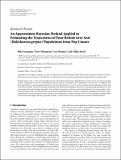Files in this item
An approximate Bayesian method applied to estimating the trajectories of four British grey seal (Halichoerus grypus) populations from pup counts.
Item metadata
| dc.contributor.author | Lonergan, Michael Edward | |
| dc.contributor.author | Thompson, David | |
| dc.contributor.author | Thomas, Leonard Joseph | |
| dc.contributor.author | Duck, Callan David | |
| dc.date.accessioned | 2014-05-01T16:01:01Z | |
| dc.date.available | 2014-05-01T16:01:01Z | |
| dc.date.issued | 2011 | |
| dc.identifier | 469603 | |
| dc.identifier | f804d5cc-7032-4bfb-9882-c535e8442521 | |
| dc.identifier.citation | Lonergan , M E , Thompson , D , Thomas , L J & Duck , C D 2011 , ' An approximate Bayesian method applied to estimating the trajectories of four British grey seal (Halichoerus grypus) populations from pup counts. ' , Journal of Marine Biology . https://doi.org/10.1155/2011/597424 | en |
| dc.identifier.issn | 1687-9481 | |
| dc.identifier.other | standrews_research_output: 32202 | |
| dc.identifier.other | ORCID: /0000-0002-7436-067X/work/29591712 | |
| dc.identifier.other | ORCID: /0000-0003-1546-2876/work/56862192 | |
| dc.identifier.uri | https://hdl.handle.net/10023/4688 | |
| dc.description.abstract | 1. For British grey seals, as with many pinniped species, population monitoring is implemented by aerial surveys of pups at breeding colonies. Scaling pup counts up to population estimates requires assumptions about population structure; this is straightforward when populations are growing exponentially, but not when growth slows, since it is unclear whether density dependence affects pup survival or fecundity. 2. We present an approximate Bayesian method for fitting pup trajectories, estimating adult population size and investigating alternative biological models. The method is equivalent to fitting a density dependent Leslie matrix model, within a Bayesian framework, but with the forms of the density dependent effects as outputs rather than assumptions. 3. This approach requires fewer assumptions than the state space models currently used, and produces similar estimates. The simplifications made the models easier to fit, reducing their computational intensity and allowing regional differences in demographic parameters to be considered. 4. The approach is not restricted to situations where only a single component of the population is observable, but, particularly in those cases, provides a practical method for extracting information from limited datasets. 5. We discuss the potential and limitations of the method and suggest that this approach provides a useful tool for at least the preliminary analysis of similar datasets. | |
| dc.format.extent | 7 | |
| dc.format.extent | 1609671 | |
| dc.language.iso | eng | |
| dc.relation.ispartof | Journal of Marine Biology | en |
| dc.subject | QH301 Biology | en |
| dc.subject | QL Zoology | en |
| dc.subject.lcc | QH301 | en |
| dc.subject.lcc | QL | en |
| dc.title | An approximate Bayesian method applied to estimating the trajectories of four British grey seal (Halichoerus grypus) populations from pup counts. | en |
| dc.type | Journal article | en |
| dc.contributor.institution | University of St Andrews. Scottish Oceans Institute | en |
| dc.contributor.institution | University of St Andrews. School of Biology | en |
| dc.contributor.institution | University of St Andrews. Statistics | en |
| dc.contributor.institution | University of St Andrews. School of Mathematics and Statistics | en |
| dc.contributor.institution | University of St Andrews. Marine Alliance for Science & Technology Scotland | en |
| dc.contributor.institution | University of St Andrews. Sea Mammal Research Unit | en |
| dc.identifier.doi | 10.1155/2011/597424 | |
| dc.description.status | Peer reviewed | en |
| dc.identifier.url | http://www.hindawi.com/journals/jmb/2011/597424/ | en |
This item appears in the following Collection(s)
Items in the St Andrews Research Repository are protected by copyright, with all rights reserved, unless otherwise indicated.

